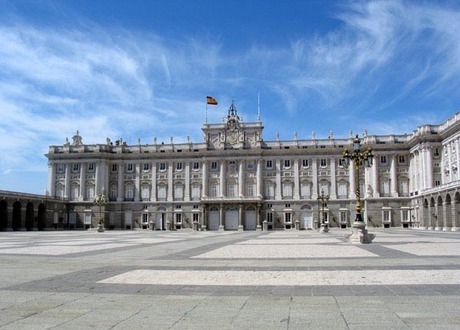Plaza de la Armería
The square as we see it now was laid out in 1892, according to a project by the architect Enrique María Repullés. However, the history of this square dates back to 1553, the year in which Philip II ordered a building to house the royal stables. Renovated in 1670 by José del Olmo, the building survived until 1884, when it had to be demolished after a fire.
The Almudena Cathedral faces the palace across the square. Its exterior is neo-classical to match its surroundings while its interior is neo-gothic. Construction was funded by King Alfonso XII to house the remains of his wife Mercedes of Orléans. The works of construction of the temple began in 1878 and concluded in 1992.
Narciso Pascual Colomer, the same architect who crafted the Plaza de Oriente, designed the layout of the plaza in 1879, but failed to materialize. The site now occupied by the Plaza de la Armería was used for many decades as anteplaza de armas. Sachetti tried to build a cathedral to finish the cornice of the Manzanares, and Sabatini proposed to unite this building with the royal palace, to form a single block. Both projects were ignored by Charles III.
The Royal Armoury in Madrid was founded at the height of the Spanish crown’s international splendour and prestige. Largely created by the Emperor Charles V (1500-1558) and his son Philip II (1556-1598), it houses the personal arms and armour of the Spanish monarchs as well as military trophies and diplomatic and family gifts. These objects became key vehicles in the transmission of an ideology of power, while they also functioned as witnesses to the historical reality of Spain and Europe in the Renaissance and Baroque periods up the end of this chapter in Spanish history, which concludes with the 18th-century Bourbons.
Considered together with the imperial of Vienna, one of the best in the world, consists of pieces ranging from the 15th century onwards. These highlight the pieces of tournament made for Charles V and Philip II by leading armorers of Milan and Augsburg. Among the most remarkable pieces stands the armory and full tools that Emperor Charles V used in the Battle of Mühlberg, and which was portrayed by Titian in the famous equestrian portrait of the Museo del Prado. Unfortunately, part of the armory was lost during the Peninsular War and during the Spanish Civil War. Still, the armory retains some of the most important pieces of this art in Europe and worldwide, including several signed by Filippo Negroli, one of the most famous architects of the guild.
Ángel Fernández de los Ríos in 1868 proposed the creation of a large wooded area that would travel all around the Plaza de Oriente, in order to give a better view of the Royal Palace. A decade later Segundo de Lema added a staircase to the original design of Fernández, which led to the idea of Francisco de Cubas to give more importance to the emerging church of Almudena.
Plaza de la Armería is right next to the Royal Palace. You can get there via flight to Madrid.




